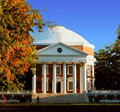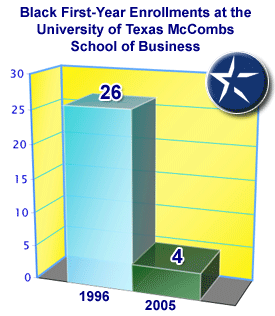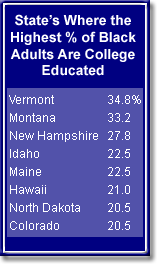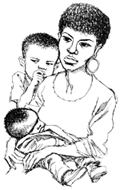University of Virginia Takes Further Steps to Open Its Campus to Low-Income Students
 Two years ago the University of Virginia established the AccessUVA program. This new financial aid effort eliminates loans for students from low-income families and replaces these loans with outright scholarship grants. This plan was modeled after a similar Princeton program initiated five years ago. Two years ago the University of Virginia established the AccessUVA program. This new financial aid effort eliminates loans for students from low-income families and replaces these loans with outright scholarship grants. This plan was modeled after a similar Princeton program initiated five years ago.
But now the University of Virginia has launched another program that will make it easier for low-income students to gain admission to the university. In 2005 the University of Virginia accepted 37 percent of students who applied for admission. Many black applicants and other students from low-income families do not have the high school grade point averages or SAT scores to meet the selective admissions requirement of the university. Many of these students end up at one of Virginia’s 23 state-operated community colleges.
 Under the new plan, students who earn an associate’s degree at a Virginia community college in a two-year period, have a cumulative grade point average of 3.4 and no grade lower than a C, and who take a specific well-rounded curriculum will be guaranteed admission to the University of Virginia as a transfer student for their junior year. Under the new plan, students who earn an associate’s degree at a Virginia community college in a two-year period, have a cumulative grade point average of 3.4 and no grade lower than a C, and who take a specific well-rounded curriculum will be guaranteed admission to the University of Virginia as a transfer student for their junior year.
With this new opportunity, high school seniors with low SAT scores, who would not be admitted under the normal admissions procedures at UVA, can decide to go to a community college and work hard to meet the stipulated requirements, knowing that, if they succeed, they will gain admission to the University of Virginia in two years. Students from low-income families who transfer to UVA from a community college under the program will be eligible for AccessUVA financial aid grants.

  |
“Certainly, everyone’s for everyone going to college. But when there’s a pronounced racial gap, what are you going to do? If we’re no longer going to engage in affirmative action to solve it, then how are you going to close the gap?”
— Victor Bolden of the NAACP Legal Defense and Educational Fund in the Columbus Dispatch, April 16, 2006
|
The Ghost of Hopwood Still Haunts Black Higher Education in Texas
In 1996 a federal appeals court ruled that the University of Texas law school could no longer use race in its admissions decisions. The ruling had a far-reaching effect on black aspirations for graduate and professional school education in Texas. Immediately after the ruling, black enrollments plummeted at the major state-operated professional schools in the state. After the 2003 Supreme Court Grutter ruling, which overturned the Hopwood decision, black enrollments have recovered at the law and medical schools of the University of Texas.
At the University of Texas McCombs School of Business, the Hopwood ruling had a major negative impact on black enrollments. In 1996 there were 26 black first-year students at the business school. The next year, after Hopwood was decided, black enrollments plummeted to six. Despite the fact that the business school now takes race into account during the admissions process, black enrollments have yet to recover. In 2005 there were just four blacks in the entering class. They made up less than 2 percent of all entering business school students.


No Progress in Increasing Black Faculty at the Nation’s Top Law Schools
A recent JBHE survey finds 107 black scholars teaching at the 25 highest-ranked law schools. They make up 7.1 percent of the 1,508 faculty members at these law schools.
Washington and Lee University had a law school faculty that was 11.8 percent black, the highest level among law schools responding to our survey.
There are 10 blacks on the law school faculty at Georgetown University, the most black scholars at any leading law school. Blacks make up 9.8 percent of the faculty at the Georgetown Law Center, the second-highest level in our survey.
The University of Southern California and Stanford University are the only other law schools among the nation’s 25 top-ranked institutions where blacks are more than 9 percent of all faculty.
 Among the Ivy League law schools, the highest percentage of black faculty was at Yale University. The six black scholars at the top-ranked Yale Law School make up 8.7 percent of the total faculty. Cornell University comes in a close second. At Cornell, there are three blacks, or 8.3 percent of the 36 faculty members at the law school. Among the Ivy League law schools, the highest percentage of black faculty was at Yale University. The six black scholars at the top-ranked Yale Law School make up 8.7 percent of the total faculty. Cornell University comes in a close second. At Cornell, there are three blacks, or 8.3 percent of the 36 faculty members at the law school.
The University of Chicago School of Law had the fewest black scholars. There is only one black faculty member among the 37 law professors at the University of Chicago. There are only two blacks on the law faculties at Berkeley, Notre Dame, Duke, and Vanderbilt. Four of the top law schools have faculties that are less than 5 percent black. They are Notre Dame, Berkeley, the University of Texas, and the University of Chicago.
In 1999 a JBHE survey found 84 black scholars at the nation’s 25 highest-ranked law schools. They made up 6.8 percent of the 1,234 faculty members at these schools. Therefore, there has been almost no progress in increasing the percentage of black scholars at our leading law schools.

States Where a High Percentage of Black Adults Are College Educated
 A new Census Bureau report reveals for the first time the educational level of black adults in each state at the time of the 2000 census. More than 30 percent of all blacks in Vermont and Montana in 2000 held a college degree. New Hampshire, Idaho, Maine, and Hawaii also had highly educated black populations. The reasons are quite clear. These states are predominantly white. Most adult blacks who now live in these states are not native born and have migrated to the locales from other regions and states. People who are able to move to different states are generally more affluent, have higher incomes, and have a higher level of education. A new Census Bureau report reveals for the first time the educational level of black adults in each state at the time of the 2000 census. More than 30 percent of all blacks in Vermont and Montana in 2000 held a college degree. New Hampshire, Idaho, Maine, and Hawaii also had highly educated black populations. The reasons are quite clear. These states are predominantly white. Most adult blacks who now live in these states are not native born and have migrated to the locales from other regions and states. People who are able to move to different states are generally more affluent, have higher incomes, and have a higher level of education.
Of the states with a small percentage of black adults with a college degree, South Carolina and Mississippi had the lowest percentage of college-educated blacks. Among northern states, blacks in Wisconsin were the least likely to have a college degree.

Complaint Lodged Against CUNY Program That Seeks to Increase Higher Educational Opportunities for Black Men
 Michael Meyers, the executive director of the right-wing New York Civil Rights Coalition, has filed a formal complaint with the Office for Civil Rights at the U.S. Department of Education. The complaint alleges that the Male Development and Empowerment Center at Medgar Evers College of the City University of New York discriminates against women and whites. The center’s purpose is to increase black male participation in higher education. Medgar Evers College has a student body that is 94 percent black and 76 percent female. Michael Meyers, the executive director of the right-wing New York Civil Rights Coalition, has filed a formal complaint with the Office for Civil Rights at the U.S. Department of Education. The complaint alleges that the Male Development and Empowerment Center at Medgar Evers College of the City University of New York discriminates against women and whites. The center’s purpose is to increase black male participation in higher education. Medgar Evers College has a student body that is 94 percent black and 76 percent female.
A similar program has been set up for the entire CUNY system to increase enrollments and to boost retention rates among black men in higher education.

Large Growth in Black-Owned Businesses, But Still a Trivial Segment of American Capitalism
JBHE research shows that with the exception of the Wharton School at the University of Pennsylvania, blacks make up 6 percent or less of the students at the nation’s highest-ranked business schools. There has been limited progress in increasing black business school enrollments in recent years.
But black entrepreneurship in the United States continues to grow. The latest report on black-owned businesses from the U.S. Census Bureau shows that in 2002 there were 1.2 million black-owned businesses in the United States, an increase of 45 percent from the previous survey in 1997.
Revenues for all black-owned businesses in 2002 were $89 billion, an increase of 25 percent from 1997.
It must be noted that black business in the United States is still a trivial segment of our economy. In 2002 the revenue of ExxonMobil, just one of thousands of large American corporations, was more than $201 billion, two and half times the revenues of all 1.2 million black-owned businesses combined.


Senator John Kerry Proposes New Grant Program for Black Colleges and Universities to Boost Entrepreneurship and Economic Development
 The increase in the number of black businesses over the past five years, as reported in the item above, is encouraging. But Senator John Kerry has proposed a program to boost entrepreneurship among blacks to an even higher level. The increase in the number of black businesses over the past five years, as reported in the item above, is encouraging. But Senator John Kerry has proposed a program to boost entrepreneurship among blacks to an even higher level.
Kerry’s Minority Entrepreneurship and Innovation Pilot Program, introduced in the Senate earlier this month, calls for 24 grants of $1 million each to black colleges and universities and other minority-serving institutions to create an entrepreneurship curriculum and to establish small business development centers on their campuses where students can receive counseling on how to start their own business once they graduate.

Grants
• The Siemens Foundation announced the first 39 winners of its Siemens Teachers Scholarships awards. Each student will receive $2,000 for the cost of his or her education at a historically black college or university. To be eligible for the scholarship grants, a student must be working toward a teaching degree in mathematics or science.
Five of the 39 winners of Siemens Teachers Scholarships are enrolled at Tuskegee University.

|
Race-Sensitive Admissions in Higher Education in the Post-Grutter Age

James Beckman's Affirmative Action Now
A new book by James A. Beckman, an associate professor of law and justice at the University of Tampa, documents the continuing importance of race-sensitive admissions in higher education today. The book, entitled Affirmative Action Now: A Guide for Students, Families, and Counselors, offers a history of affirmative action in higher education with special emphasis on what has transpired since the 2003 Supreme Court ruling in Grutter v. Bollinger, which reaffirmed the right of colleges and universities to consider race in their admissions decisions.
A huge 240-page appendix lists the affirmative action admissions policy of every four-year college and university in the United States with an enrollment greater than 500 students. All told, Professor Beckman found 488 colleges and universities that continue to practice race-sensitive admissions. The appendix also lists the black percentage of the student body at each school. Therefore, the appendix is a valuable reference tool for all college-bound African-American students.

Assessing the Damage to Black Higher Education From Right-Wing Efforts to Ban Minority Scholarship Programs
 Ohio State University is one of more than 200 colleges and universities that have received letters from the Center for Equal Opportunity threatening litigation unless the university opened up to students of all races programs that had been reserved for blacks or other minorities. Ohio State University is one of more than 200 colleges and universities that have received letters from the Center for Equal Opportunity threatening litigation unless the university opened up to students of all races programs that had been reserved for blacks or other minorities.
In response, Ohio State adjusted and renamed its Minority Scholars Program so that scholarship money would be available to students of all races. The new Morrill Scholars Program is open to applicants of all races, with students from Appalachia or who are the first generation in their families to attend college given preference over other applicants.
As a result of the change, this year 148 of the 705 recipients of scholarships are white. Previously all money in the program went to minority students.

Black Colleges and Universities With Improving Graduation Rates
JBHE has collected student graduation rate statistics going back to 1998 for a group of 41 historically black universities. The good news is that during this period, 26 of the 41 colleges and universities have seen an improvement in their black student graduation rates.
Over the past seven years there have been huge differences in graduation rates at some of these HBCUs. For example, the black graduation rate at Fisk University increased from 46 percent in 1998 to 64 percent today. In 1993 the black student graduation rate at Fisk was only 25 percent. Other schools showing large improvements in their black student graduation rates are Alcorn State University in Mississippi, Lincoln University in Missouri, the University of Maryland Eastern Shore, and Morehouse College. All of these black colleges and universities have seen a 10 percentage point or more rise in black student graduation rates over the past seven years.

How Parenthood Affects the Black-White College Graduation Rate Gap
 A recent study published in the journal Research in Higher Education finds that 32 percent of black women reported having had a child within five years of entering a four-year college. For white women, the rate was only 7 percent. Some 23 percent of black men entering a four-year college reported having had a child within five years of entering higher education. For white men, the rate was 4 percent. A recent study published in the journal Research in Higher Education finds that 32 percent of black women reported having had a child within five years of entering a four-year college. For white women, the rate was only 7 percent. Some 23 percent of black men entering a four-year college reported having had a child within five years of entering higher education. For white men, the rate was 4 percent.
The study found that women of both races who had a baby within five years of entering college were far less likely to graduate than women who had no children or waited at least five years after entering college to give birth. The authors conclude that “due to the diversion of time and money away from pursuit of a degree, having a child is a direct cause of leaving college.” Since black women are more than four times as likely to give birth soon after they enter college, becoming a parent likely is a significant contributing factor to the overall racial gap in college graduation rates.

Mid-continent Research for Education and Learning (McREL)

Vice President of Research & Evaluation
Join Mid-continent Research for Education and Learning (McREL), an internationally recognized, nonprofit organization located in Denver, Colorado. In addition to contributing to the body of knowledge in educational research, McREL provides products and services primarily for K-12 educators to promote best instructional practice. Established in 1966, McREL maintains steady growth and provides a wide variety of services regionally, nationally, and internationally. Our staff of approximately 100 employees is comprised of dedicated experts with a wide range of education-related experience.
McREL seeks culturally and professionally diverse applicants for the full time position of VP of Research & Evaluation. Provide ambitious leadership and play a central role in directing a top-flight group of research and evaluation professionals. Must have a vision, energy, and a rich combination of experience and personal qualities to support the continuing development of our nonprofit organization.
Education and experience needed to qualify for this unique position include:
• Ph.D. in Research or Evaluation methodology
• Prior experience as a senior director or center director
• Supervision of a research or evaluation unit, including budgeting and project management.
• Experience managing a diversified portfolio of research and evaluation grants and products
• New business development efforts
• Proven track record with successful grants and contracts
• Experience in leadership at the highest level of an organization
Application materials may also be emailed and must include a letter of interest, resume, and contact information for three references in Word format. To explore this career of a lifetime, forward your materials to:
VP of Research & Evaluation Opportunity
McREL
4601 DTC Blvd, #500
Denver, CO 80237
resumes@mcrel.org / www.mcrel.org
All candidates will be notified as materials are received. Additional information about McREL may be obtained at www.mcrel.org. We are an equal opportunity/affirmative action employer. Persons from diverse backgrounds are encouraged to apply.
In Omaha, Racial Segregation of Schools Is a Fact of Life, But a New Plan Seeks to Make the Best of a Bad Situation
The city of Omaha’s public schools are 46 percent white, 31 percent black, and 20 percent Hispanic. Now, the city is breaking up its public school district into three separate entities. Because of rigid residential segregation in the city, one of the new school districts is nearly all white, one is predominantly black, and one is predominantly Latino.
 Proponents of the plan, including state senator Ernie Chambers, the only black in the state legislature, believe the new system will give blacks greater control over school resources. He believes that schools in black neighborhoods were being shortchanged in the allocation of resources by the white-dominated school administration in the citywide district. Chambers stated that since busing to increase racial integration of the city’s schools had been abolished, the schools were already segregated by race and that the new administrative formula would have no impact on the racial makeup of schools. Proponents of the plan, including state senator Ernie Chambers, the only black in the state legislature, believe the new system will give blacks greater control over school resources. He believes that schools in black neighborhoods were being shortchanged in the allocation of resources by the white-dominated school administration in the citywide district. Chambers stated that since busing to increase racial integration of the city’s schools had been abolished, the schools were already segregated by race and that the new administrative formula would have no impact on the racial makeup of schools.

Black Student Sentenced in Hate Crime Hoax at Trinity International University
 In a well-publicized incident last year, Alicia Harden, an African-American student at Trinity International University in Deerfield, Illinois, admitted to writing letters filled with racial slurs and threats to two fellow black students. Harden admitted to police that she was unhappy at the university and perpetrated the hoax so that her parents would bring her home fearing for her safety on campus. Blacks make up about 13 percent of the student body at the university. In a well-publicized incident last year, Alicia Harden, an African-American student at Trinity International University in Deerfield, Illinois, admitted to writing letters filled with racial slurs and threats to two fellow black students. Harden admitted to police that she was unhappy at the university and perpetrated the hoax so that her parents would bring her home fearing for her safety on campus. Blacks make up about 13 percent of the student body at the university.
Harden was sentenced earlier this month to two years’ probation and ordered to perform 200 hours of community service. She also must pay $2,000 in restitution to the university.

  |
31.4% Percentage of black adults in the United States over the age of 25 in 1970 who were high school graduates.
72.3% Percentage of black adults in the United States over the age of 25 in 2000 who were high school graduates.
source: U.S. Bureau of the Census
|
Harvard Solicits Advice on the Selection of Its Next President
As JBHE has noted on many occasions, the selection of the next president of Harvard University is important to African Americans. Harvard’s next president will be looked to for leadership on such issues as affirmative action in admissions, race-based scholarship programs, and whether black studies should remain an important area in the curriculum of our nation’s great educational institutions.
 The search committee to find a replacement for Lawrence Summers has just begun its work. In an initial effort, the committee sent out 20,000 e-mail messages to students, faculty, and staff members of the university seeking advice on whom to select. In addition, 200,000 alumni of the institution will be asked for their views as to who should be the next president of Harvard. The search committee to find a replacement for Lawrence Summers has just begun its work. In an initial effort, the committee sent out 20,000 e-mail messages to students, faculty, and staff members of the university seeking advice on whom to select. In addition, 200,000 alumni of the institution will be asked for their views as to who should be the next president of Harvard.

Finally, Some Good News for Charles R. Drew University of Medicine
 In welcome news, the Accreditation Council for Graduate Medical Education announced recently that the Charles R. Drew University of Medicine in Los Angeles would maintain its full accreditation. The university, which trains mainly African-American and Latino physicians, had received unfavorable reviews in both 2001 and 2003. A third unfavorable review would have resulted in a loss of accreditation. In welcome news, the Accreditation Council for Graduate Medical Education announced recently that the Charles R. Drew University of Medicine in Los Angeles would maintain its full accreditation. The university, which trains mainly African-American and Latino physicians, had received unfavorable reviews in both 2001 and 2003. A third unfavorable review would have resulted in a loss of accreditation.
The announcement that the university would retain its overall accreditation does not affect the training programs in surgery, radiology, or neonatology, which previously had been shut down by the accrediting agency.

Black College Knocks Down the National Powerhouse in Collegiate Bowling
The black colleges usually operate on the fringe of big-time collegiate sports. This is because the black colleges tend to have much smaller student bodies than the athletic powerhouses. The black colleges also have far less money to use for athletic scholarships, travel budgets, and sports training equipment.
But this year, a black college produced a remarkable effort that resulted in the opportunity to play for a national championship.
 Going into the NCAA women’s bowling tournament this month in Houston, the University of Nebraska was rated No. 1 in the nation and the favorite to win its third straight title. Going into the NCAA women’s bowling tournament this month in Houston, the University of Nebraska was rated No. 1 in the nation and the favorite to win its third straight title.
But in the semifinals of the tournament, the women’s team from Alabama A&M University, the historically black educational institution in Normal, Alabama, shocked the University of Nebraska by defeating the Cornhuskers 4-2.
The Bulldogs from Alabama A&M went on to the finals but dropped the championship match to Fairleigh Dickinson University of New Jersey.

Awards
 • Shelby Steele, senior research fellow at the Hoover Institution at Stanford University, will be one of four recipients of the Bradley Prize at a gala ceremony at the Kennedy Center in Washington, D.C., next month. The $250,000 prize is awarded by the conservative Lynde and Harry Bradley Foundation. • Shelby Steele, senior research fellow at the Hoover Institution at Stanford University, will be one of four recipients of the Bradley Prize at a gala ceremony at the Kennedy Center in Washington, D.C., next month. The $250,000 prize is awarded by the conservative Lynde and Harry Bradley Foundation.
 • Winston Anderson, professor of biology at Howard University in Washington, D.C., received one of 20 awards given for the Best Scientists in Academia from the Howard Hughes Medical Institute. The award includes $1 million which the institute hopes will be used to promote scientific research in the undergraduate classroom. Professor Anderson will use the money to establish a summer exchange program that will send students to Africa to study tropical diseases. • Winston Anderson, professor of biology at Howard University in Washington, D.C., received one of 20 awards given for the Best Scientists in Academia from the Howard Hughes Medical Institute. The award includes $1 million which the institute hopes will be used to promote scientific research in the undergraduate classroom. Professor Anderson will use the money to establish a summer exchange program that will send students to Africa to study tropical diseases.
 • Peter J. Gomes, Plummer Professor of Christian Morals and Pusey minister of the Memorial Church at Harvard University, was presented with the 2006 Preston N. Williams Award from the alumni association of Harvard Divinity School. The award is given to a scholar who has shown a concern for the religious experience of the African diaspora. • Peter J. Gomes, Plummer Professor of Christian Morals and Pusey minister of the Memorial Church at Harvard University, was presented with the 2006 Preston N. Williams Award from the alumni association of Harvard Divinity School. The award is given to a scholar who has shown a concern for the religious experience of the African diaspora.

|



